Nasrid Palaces
History, Islamic art, and architecture of the Palaces
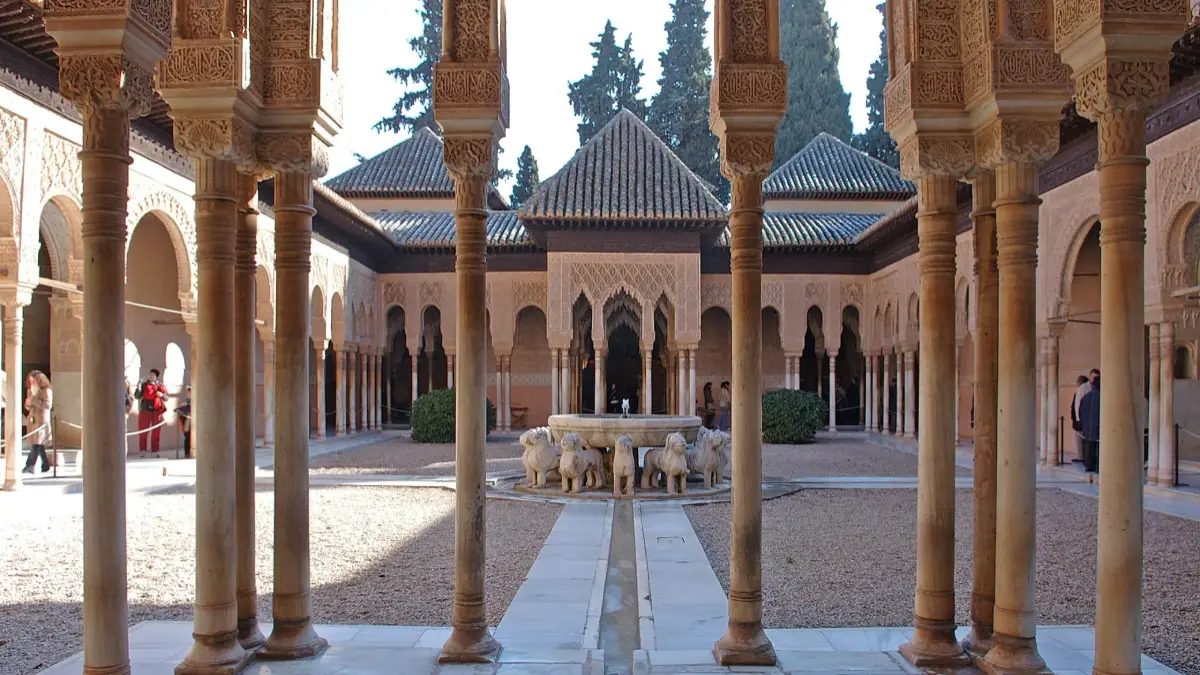
The Nasrid Palaces are the most stunning and refined part of the Alhambra complex in Granada, and reflect the peak of Islamic art and architecture in Al-Andalus.
Built in the 14th century by the Nasrid dynasty, these palaces were designed to impress, with intricate decoration, peaceful courtyards, and beautifully crafted rooms.
In this article, you’ll explore the rich history of the Nasrid Palaces, discover key areas like the Court of the Lions and Hall of the Ambassadors, and learn what makes this royal residence a masterpiece of Moorish design.
The Alhambra Castle attracts over 2.6 million visitors annually, so booking in advance is a smart choice. The skip-the-line ticket is the most popular and budget-friendly option. For a deeper understanding of the palace, the guided tour offers expert insights, while the night tour provides a magical experience in a peaceful atmosphere.
History of Nasrid Palaces
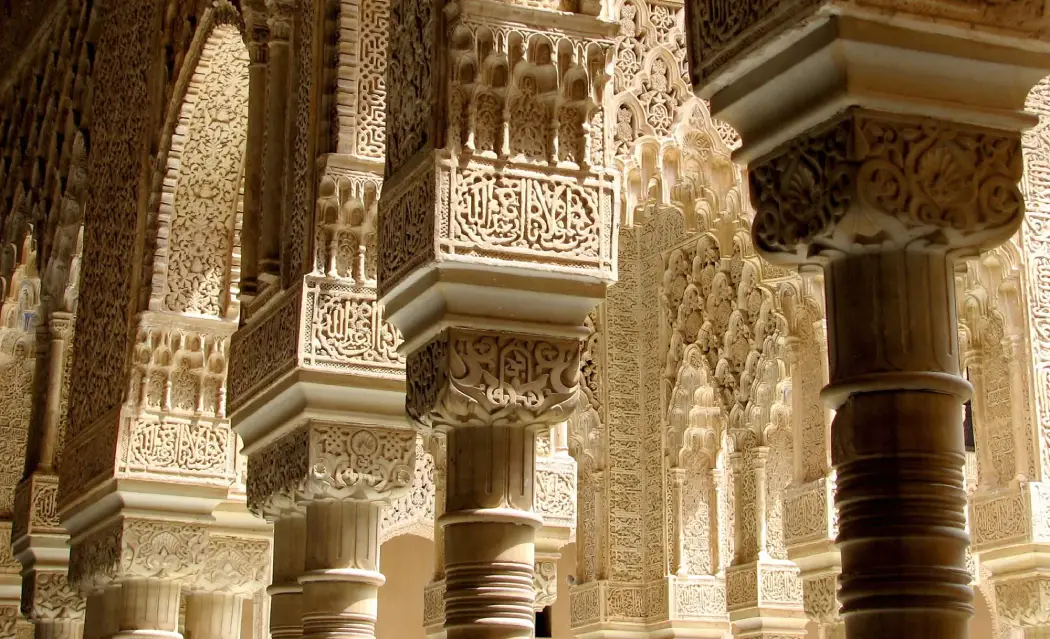
The Nasrid Palaces were mainly built in the 14th century by Yusuf I and his son Mohammed V, rulers of the Nasrid dynasty in Granada.
Early construction began under Abu l-Walid Ismail, but it was Yusuf I who transformed the Palaces, adding the Comares Tower, Court of the Myrtles, and Royal Baths.
Mohammed V later expanded these structures and built the famous Palace of the Lions, blending Islamic and Christian styles.
After the Christian conquest in 1492, the palaces were used by the Catholic Monarchs and later modified by Charles V.
Despite changes and damage over the centuries, major restorations in the 20th century helped preserve their original beauty. Today, the Nasrid Palaces are a masterpiece of Islamic architecture and a highlight of Alhambra.
Key areas inside the Nasrid palaces
The Nasrid Palaces are divided into three main sections: the Mexuar, the Comares Palace, and the Palace of the Lions.
Mexuar Hall (Sala del Mexuar)
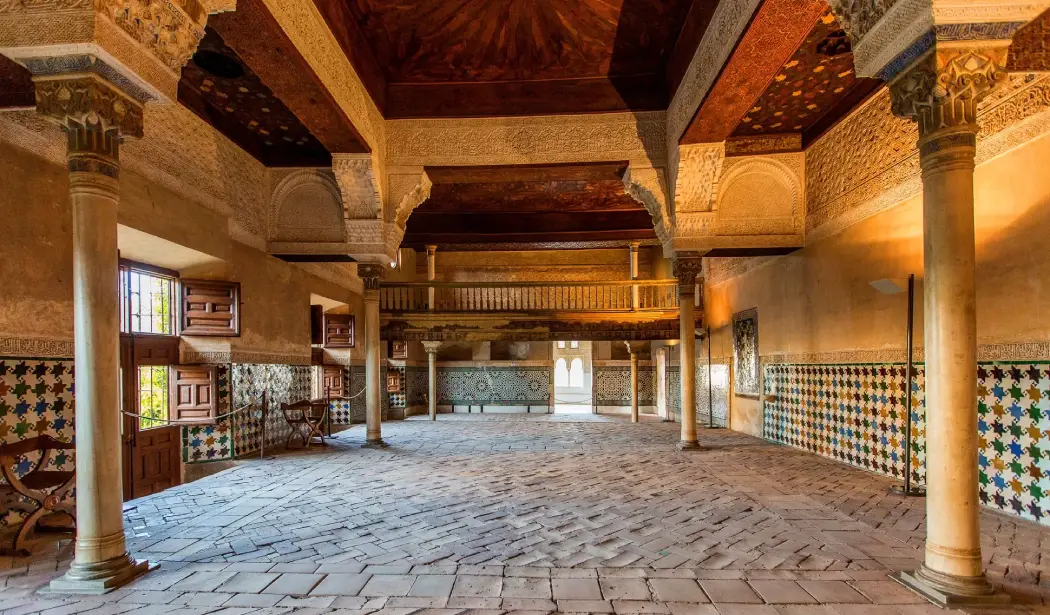
The Mexuar is one of the oldest parts of the Alhambra, built by the Nasrid rulers. It changed significantly over the years, especially after an explosion in 1590. Later, the Catholic Monarchs also made their own changes.
Today, you can still see the Mexuar Hall with its four columns and a wooden ceiling from the Christian period.
The walls have tiles and an important message: “Everything you own comes from God.” The hall was used for royal meetings and later turned into a Christian chapel in 1632.
The Comares Palace (Cuarto or Palacio de Comares)
The Comares Palace was the official residence of the king in Alhambra.
The palace was originally designed by Yusuf I, who wanted it to impress all visitors with its beauty and decoration. However, he likely didn’t live to see it finished.
His son, Mohammed V, completed the palace and added more elements, including a decorated façade on the south side of the Patio of the Gilded Room (Patio del Cuarto Dorado).
It includes several rooms that surround the Court of the Myrtles (Patio de los Arrayanes). These rooms have beautiful covered walkways (galleries) with arches at each end.
To the north is the Hall of the Boat (Sala de la Barca), and inside the Comares Tower (Torre de Comares) is the stunning Hall of the Ambassadors (Salón de los Embajadores), which offers a great view of the Darro River valley.
Palace of the Lions (Palacio de los Leones)
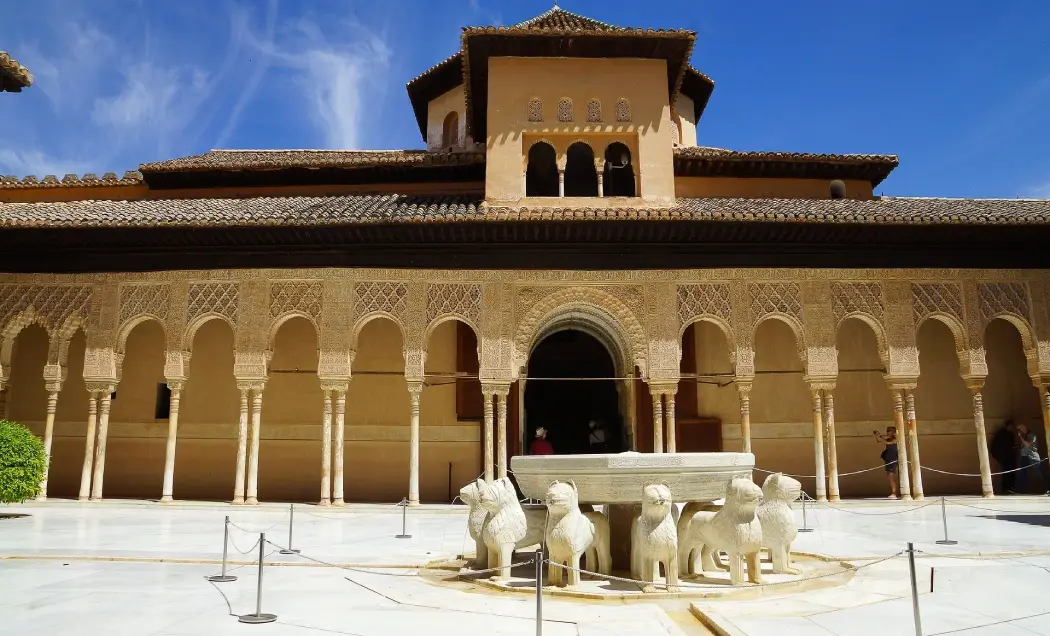
Mohammed V built the Palace of the Lions around 1377 as the private royal residence. It was added near the Baths and the Court of the Myrtles.
The courtyard once had a garden, and four water channels flowed from each room to the center, symbolizing the four rivers of paradise in Islamic belief.
The design reflects Islamic ideas of paradise as inward-looking, peaceful, and garden-like. Later additions, like the wooden eaves, were made in the 19th century.
Court of the Lions (Patio of the Lions)
The Court of the Lions is the central courtyard within the larger Palace of the Lions complex. It is one of the most famous parts of the Alhambra, named after the twelve marble lions that support a dodecagon-shaped fountain in the center.
Built by Mohammed V, the fountain is a key example of Islamic sculpture, and it features a poem by Ibn Zamrak carved along its edge.
Water flows from channels that form a cross pattern, connecting the fountain to nearby halls and pavilions.
The rectangular courtyard is surrounded by a gallery with 124 marble columns, resembling a Christian cloister rather than a typical Andalusian patio.
The arches are richly decorated with mocarabes, carvings, and inscriptions. The gallery leads to the Hall of the Abencerrajes and the Hall of the Two Sisters, with the sultan’s wives’ chambers located above.
Hall of Two Sisters
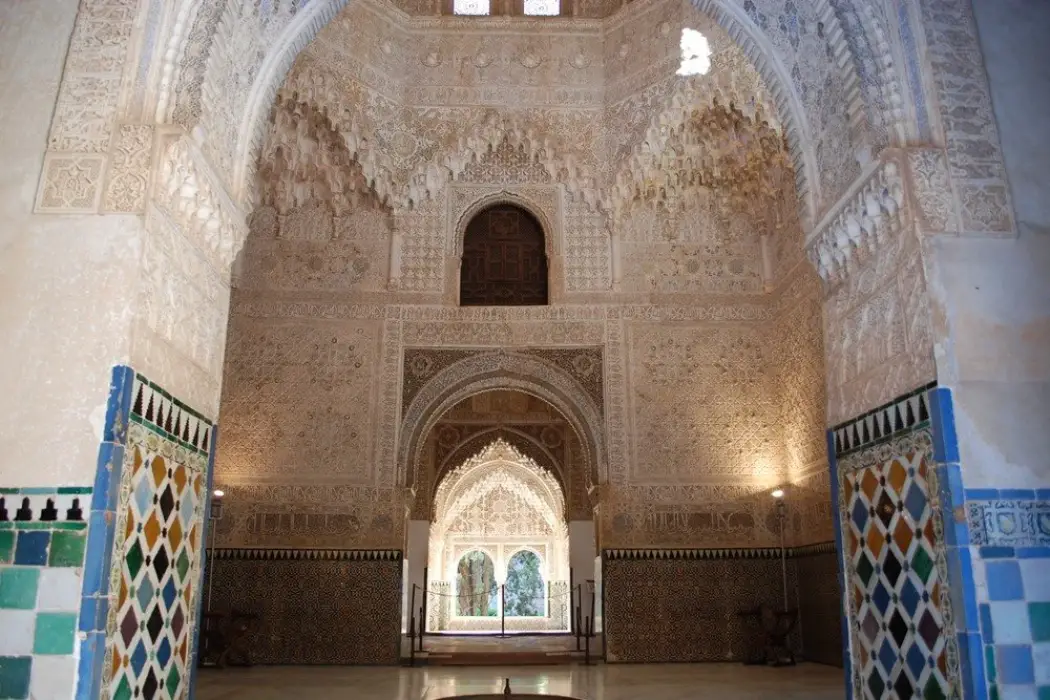
The Hall of the Two Sisters was also built by Mohammed V and gets its name from two large, identical marble slabs on the floor. It was part of the royal living quarters, where the sultana and Boabdil’s mother once stayed.
The hall connects to the Emperor’s Chambers, Gardens of the Partal, and offers views of the Patio of the Lions through arches and balconies.
Its highlights include a marble floor, a small fountain, and a stunning mocarabes (honeycomb) dome lit by small side windows.
The walls are decorated with fine plasterwork, Arabic calligraphy, and the Nasrid motto “Only God is Victor.” A poem by Ibn Zamrak about the dome is also inscribed on decorative tiles.
Hall of Kings
The Hall of the Kings is named after a painting on its central dome showing ten Nasrid kings. It was also known as the Hall of Justice in the 18th century.
The hall is divided into three square rooms, two rectangular sections, and two small chambers at the ends, all topped with mocarabes domes that create a beautiful play of light.
The paintings, likely made during the reign of Mohammed VII or Yusuf III, show kings, hunting scenes, and romantic stories. Though they depict Muslim figures, the art style is Christian-influenced.
Only a few fragments of the hall’s original tile and plaster decoration still remain today.
Hall of Abencerrajes
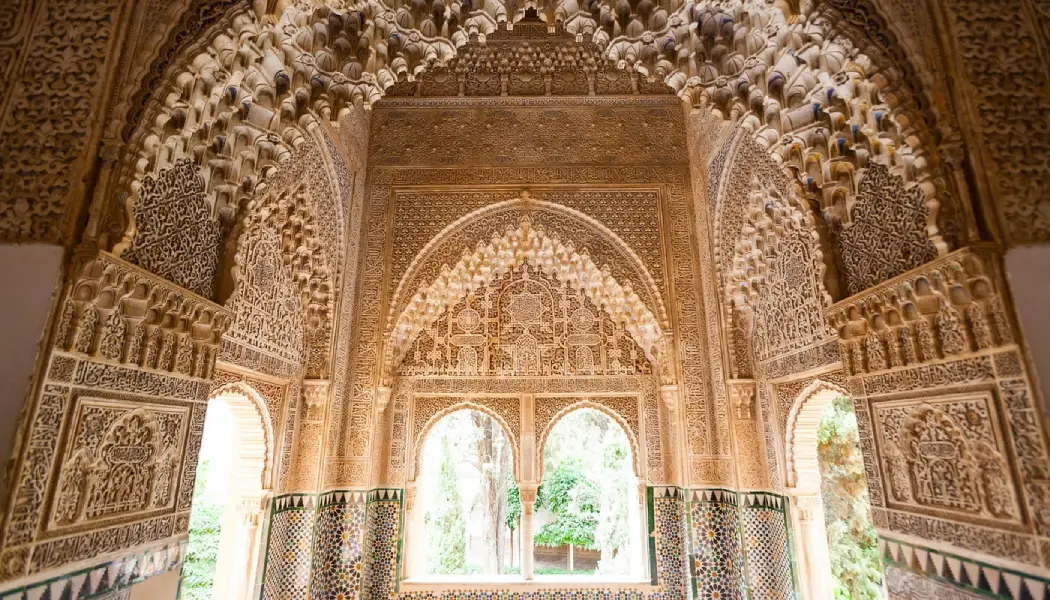
The Hall of the Abencerrajes is located opposite the Hall of the Two Sisters. It’s named after a legend that says the Abencerrajes knights were beheaded here, though historians are unsure which king ordered it.
A rust-colored stain in the central marble fountain is believed by some to be a trace of their blood.
The hall has a central square area with side chambers, decorated arches, blue capitals, and painted wooden ceilings. The walls feature detailed plasterwork and 16th-century Renaissance tiles.
Above is a stunning mocarabes dome, supported by eight richly carved pendentives, with an Arabic inscription praising God’s mercy. Soft light enters through the windows, creating a peaceful and magical feel.
Islamic art and architectural style of Nasrid Palaces
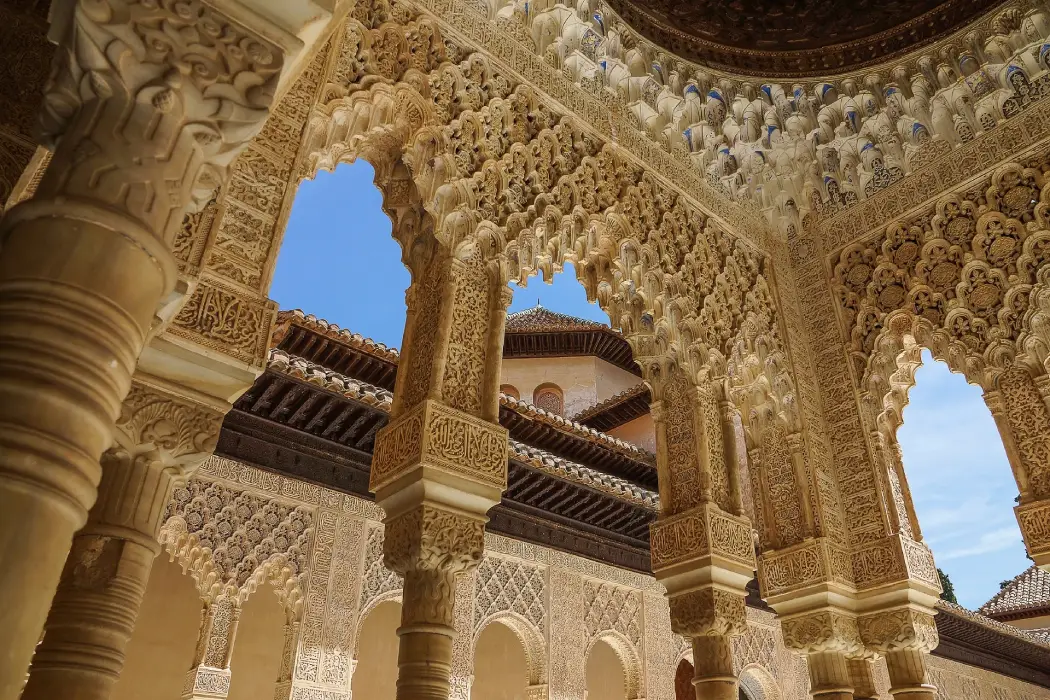
The Nasrid Palaces are one of the most beautiful examples of Islamic architecture in Spain. These palaces were designed to show the power and wealth of the rulers of Alhambra.
The Palaces include a series of connected rooms, gardens, and courtyards, each decorated with detailed stucco work, colorful tiles, mosaics, and wooden ceilings.
The walls are decorated with inscriptions from the Qur’an, poetry, and praise for Allah and the Nasrid rulers. Features like muqarnas (honeycomb-shaped vaults), horseshoe arches, and fine stucco work add a feeling of elegance and lightness throughout the palace.
Visitors can explore stunning areas like the Court of the Lions, Hall of the Two Sisters, and the Mexuar, each showcasing the beauty of Islamic art.
The palaces are also full of fountains and reflecting pools, creating a peaceful and elegant atmosphere.
Every detail was carefully crafted by skilled Nasrid and Mudéjar artists, making the Nasrid Palaces a true treasure of Andalusian heritage and a must-see for anyone visiting Alhambra.
